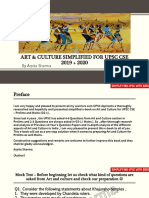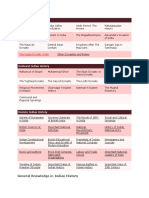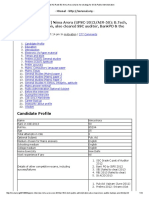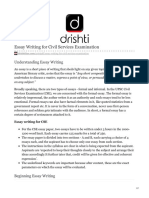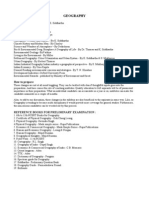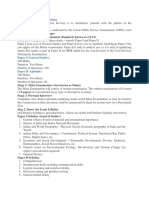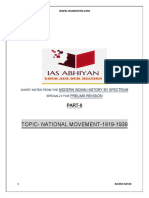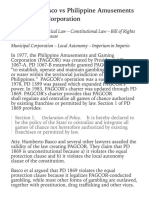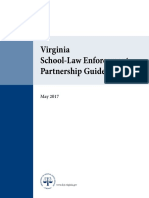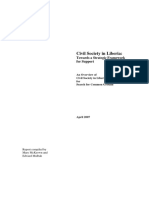0 ratings0% found this document useful (0 votes)
240 viewsAnudeep Durishetty-Free Chapter GS2
Anudeep Durishetty-Free Chapter GS2
Uploaded by
Vicky SinghThis document provides tips for improving essay writing and answering questions for the GS-2 portion of the UPSC civil services exam. It discusses preparing for both the static and current portions of the syllabus. Specific tips include opening answers with relevant constitutional articles, arguing both sides of an issue rather than taking a side early on, using subheadings that mirror the question, citing relevant data and statistics, and referencing important Supreme Court judgments. The document is an excerpt from an upcoming book on essay and answer writing by Anudeep Durishetty, who secured AIR 1 on the UPSC CSE 2017.
Copyright:
© All Rights Reserved
Available Formats
Download as PDF, TXT or read online from Scribd
Anudeep Durishetty-Free Chapter GS2
Anudeep Durishetty-Free Chapter GS2
Uploaded by
Vicky Singh0 ratings0% found this document useful (0 votes)
240 views21 pagesThis document provides tips for improving essay writing and answering questions for the GS-2 portion of the UPSC civil services exam. It discusses preparing for both the static and current portions of the syllabus. Specific tips include opening answers with relevant constitutional articles, arguing both sides of an issue rather than taking a side early on, using subheadings that mirror the question, citing relevant data and statistics, and referencing important Supreme Court judgments. The document is an excerpt from an upcoming book on essay and answer writing by Anudeep Durishetty, who secured AIR 1 on the UPSC CSE 2017.
Original Description:
Upsc notes
Original Title
Anudeep Durishetty—Free Chapter GS2
Copyright
© © All Rights Reserved
Available Formats
PDF, TXT or read online from Scribd
Share this document
Did you find this document useful?
Is this content inappropriate?
This document provides tips for improving essay writing and answering questions for the GS-2 portion of the UPSC civil services exam. It discusses preparing for both the static and current portions of the syllabus. Specific tips include opening answers with relevant constitutional articles, arguing both sides of an issue rather than taking a side early on, using subheadings that mirror the question, citing relevant data and statistics, and referencing important Supreme Court judgments. The document is an excerpt from an upcoming book on essay and answer writing by Anudeep Durishetty, who secured AIR 1 on the UPSC CSE 2017.
Copyright:
© All Rights Reserved
Available Formats
Download as PDF, TXT or read online from Scribd
Download as pdf or txt
0 ratings0% found this document useful (0 votes)
240 views21 pagesAnudeep Durishetty-Free Chapter GS2
Anudeep Durishetty-Free Chapter GS2
Uploaded by
Vicky SinghThis document provides tips for improving essay writing and answering questions for the GS-2 portion of the UPSC civil services exam. It discusses preparing for both the static and current portions of the syllabus. Specific tips include opening answers with relevant constitutional articles, arguing both sides of an issue rather than taking a side early on, using subheadings that mirror the question, citing relevant data and statistics, and referencing important Supreme Court judgments. The document is an excerpt from an upcoming book on essay and answer writing by Anudeep Durishetty, who secured AIR 1 on the UPSC CSE 2017.
Copyright:
© All Rights Reserved
Available Formats
Download as PDF, TXT or read online from Scribd
Download as pdf or txt
You are on page 1of 21
This is an exclusive chapter excerpt from my
upcoming book, Fundamentals of Essay and
Answer Writing. There will be similar chapters on
GS-1,3,4 and Essay writing.
If you are a subscriber to my blog, you will be the
first to hear it when it launches. If you haven’t
subscribed yet, you can sign up here.
Fundamentals of
Essay and Answer
Writing
Anudeep Durishetty
AIR 1, UPSC CSE 2017
General Studies- 2
GS-2 is tricky in the sense that it’s easy to find sources for
the topics, and prepare for them thoroughly, yet for many
aspirants, scoring above 100 feels like an uphill task. In this
chapter, we will break down the syllabus, examining each
segment in detail, discussing what changes you can bring in
your preparation and answer presentation to improve your
scores.
Syllabus under GS-2 can be classified into two segments:
I. Polity, Governance & Social Justice
II. International Relations.
This paper revolves around current affairs and the
mistake many aspirants commit while preparing for this
paper is that they focus too much on the current part, leaving
out the equally important static portion. We must remember
that to write good answers in any GS paper, one needs to
have a firm grip over both the static portion (which includes
the underlying principles/constitutional articles/facts/data
etc) and the current affairs. In the following sections, I lay
out some fundamental guidelines for answering GS-2
questions.
I. Polity, Governance and
Social Justice
Questions from this topic pertain to Constitution,
Government schemes, laws, governance and development
sector etc, linking them all to some current affair issue. So to
answer the questions well, you need to balance your answer
between current and the static and write it in a structured
manner. The following tips will help you to present the
content effectively.
Tip 1: Opening your answers with Constitutional
articles
Example: “The local self-government system in India has
not proved to be effective instrument of governance”. Critically
examine the statement and give your views to improve the
situation.
I started the answer as follows:
A: 73rd and 74th amendments to the Constitution
established local self government in India. Some important
articles pertaining to local government are 243A (Gram
Sabha), 243B (Panchayats), 243G & 243W(Powers and
responsibilities of Panchayats and Municipalities), 243 ZD & ZE
(District and Metropolitan Planning Committee).
This is a simple rule of thumb for Polity related questions,
but works remarkably well. Whenever I read a question that
had Constitutional relevance, I simply started with the article
number. Mentioning the article number will convey to the
examiner that you have a fundamental idea of the principles
of the Constitution and how it operates. Also, memorising
them serves another useful purpose. Sometimes questions are
asked purely based on the Constitutional articles themselves
without revealing other details. If you can’t figure out what
that Article refers to, you will be in no position to attempt
that question. For instance, consider the following question:
“The Supreme Court’s use of its vast powers under Article
142 may have done tremendous good. However, it’s time to
have some checks and balances.” Critically analyse the
statement citing recent judgements.
If you don’t know what Article 142 refers to, you’ll be left
clueless in such questions. Hence it’s critical that you
remember them like the back of your hand. At first, it might
seem difficult to memorise so many, but with enough
revisions, it isn’t that hard. Knowing Constitutional articles
will help you across every stage and paper of the exam—
Prelims, Essay, GS and even the interview. Invest enough
effort in memorising them, it’s worth your time.
List of important articles is too big to fit in here. It’s
readily available on my blog link: anudeepdurishetty.in.
Tip 2: In an opinion based question, argue both
sides and reserve your opinion for the conclusion
In GS 2, questions are usually asked on contentious
topics where there is a possibility to take more than one view.
In such questions, it always helps to mention both sides of
the argument even if not explicitly asked in the question. And
club these arguments under relevant subheadings (arguments
for/ arguments against) to mark a clear distinction between
both. To illustrate, consider this question: “Simultaneous
election to the Lok Sabha and the State Assemblies will limit the
amount of time and money spent in electioneering but it will
reduce the government’s accountability to the people. Discuss.”
This is a debatable topic and one may agree or disagree with
the statement. A common mistake aspirants commit is to take
a side in the introduction itself and use rest of the answer to
justify it incessantly. A better approach is to present both
sides of the topic with substantiation (data, facts, reasoning)
and conclude the answer with what you think is right.
Tip 3: Subheadings that resemble the terms in the
question
Adding subheadings in the main body of the answer helps
in two ways: One, it will help you break down the question
into smaller, manageable chunks and two, it will help you
stay close to the topic that’s being asked. It will convey to the
examiner that you are precisely answering the question. For
the question: Explain the salient features of the constitution
(One Hundred and First Amendment) Act, 2016. Do you think
it is efficacious enough ‘to remove cascading effect of taxes and
provide for common national market for goods and services’?
Subheadings for this question would be:
• Salient Features of the Act
• GST and Cascading Of Taxes
• GST and Common National Market
• Problems in the current Act
• Way forward/Suggestions
Observe how the terms in the subheadings closely mimic
the terms in the question. They also make your answer easy
to comprehend for the examiner.
Tip 4: Quote data, statistics and relevant laws to
strengthen your point
GS-2 is mostly analysis based paper with questions
asking for your opinion. Merely writing arguments without
facts and data would make your answers shallow. You must
be armed with data and facts and mention them wherever
apt. They make your arguments credible. If you want to say
that India is struggling under the burden of NPAs— mention
by how much, and what’s the trend of such NPA figures— is
it increasing or decreasing? If you want to argue how India’s
public health is in bad shape, back it up with numbers like
IMR, high percentage out of pocket expenditure, MMR,
scarcity of doctors, WHO standards etc.,
Further, you can also cite authentic reports from reputed
international and national organisations to drive home your
point. For instance Transparency International report findings
on corruption, ASER on education etc.
Tip 5: Supreme Court Judgements
These add incredible value and authority to your
arguments. In Mains, it’s always the opinion of the experts
that matter. We merely convey those expert opinions. Since
Supreme Court is the ultimate interpreter of laws and the
Constitution, we must know about the landmark judgments
of the Apex court and use them wherever relevant. I am
including below some of the important judgments in
independent India’s history. These are by no means
exhaustive. If you think I have missed some important
judgements, please append them to this list and prepare.
I M P O R TA N T S U P R E M E C O U R T J U D G E M E N T S
CASE JUDGEMENT
SR Bommai Kept a check on the powers under
Article 356.
Keshavananda Bharati Propounded the concept of Basic
Structure of the Constitution
Waman Rao, Minerva Mills Upheld that Judicial review is
part of the basic structure
I.R. Coelho Clarified the limits of Ninth
Schedule of the Constitution and
upheld importance of basic
structure
Navtej Singh Johar Stuck down Sec 377 of IPC
Maneka Gandhi Interpreted scope of Art 21 and
gave the concept of due process
of law
AK Gopalan Interpreted scope of Art 21 and
gave the concept of procedure
established by law
Golaknath Held that Parliament cannot
curtail any of the Fundamental
rights
Kedar Nath Singh Clarified the scope of Sedition
under Sec 124A
Hussainara Khatoon Judgement on the plight of
undertrials. Genesis of PIL.
Olga Tellis Adjudicated on the rights of
pavement dwellers
Bachan Singh Gave the ‘rarest of rare’ doctrine
for awarding death penalty.
Sheela Bharse On custodial violence against
women. Case was taken up based
on a simple letter from a
journalist.
Indira Sawhney Adjudicated on the scope and
extent of Art 16 (4) that provided
for reservation
Vishakha Established guidelines to prevent
sexual harassment at workplace.
Samatha Upheld tribal rights
Three Judges Cases Genesis of Collegium system
Shreya Singhal Struck down Sec 66A of IT Act,
2000
Puttaswamy (Privacy case) Upheld Right to privacy as a
fundamental right
Lily Thomas On disqualification of convicted
elected representatives
Shah Bano Begum Gave precedence to individual
rights over personal laws.
Tip 6: Remembering the recommendations of important
Committees and Commissions (can be used in
conclusion)
For this paper, every committee that’s in news is
important. But apart from these current affairs related ones,
there are a few core committees of the past whose
observations and recommendations have remained timeless.
You can quote them in your answers to substantiate your
opinion, especially in conclusion. The following list is not
exhaustive.
• 1st ARC
• 2nd ARC
• Sarkaria Commission
• Puncchhi Commission
• Law Commission Reports
• NCRWC
Tip 7: Illustrate wherever apt
Illustrations and diagrams should be drawn when it meets
two conditions:
• When it helps you express more content concisely and
in less time
• It adds value and illuminates your answer by way of
introducing or explaining a concept simply; conveying
geographical spread on a map etc.,
So if you find an info-graphic or a map or a graph in the
newspaper or the internet, note them down and illustrate in
your answers. In the Mains exam, I drew diagram for the GST
related question as below to show how it overcomes the
problems of cascading of taxes:
So prepare for such illustrations before hand. We will discuss
about illustrations and diagrams in detail in another chapter.
II. International Relations
Mastering IR is about grasping a few
fundamentals and implementing them in your answers. I list
them below.
A. Understand the historical backdrop of a diplomatic
relation
With respect to every major bilateral relationship, you
must know about history and all the important agreements/
treaties we had signed with those countries. For instance,
Indo-Nepal treaty of Friendship, Kyoto protocol, Indo-Sri
Lanka accord etc. might be dated agreements, but you must
have a fair idea about them. List 4-5 core points of each
agreement, and understand them. Adding these will add
authority to your answers.
B. Factual position about a current affair issue related to
that particular question
For every current affair issue, have thorough factual
knowledge. Example: If International Court of Justice is in
news, you must read and understand about ICJ, its structure
and mandate, how cases are referred to it etc., It will help
you write better answers.
C. Use subheadings to break down the question and
answer in parts
Same as I dealt in the Polity section above
D. Write a multi-dimensional answer relating to that
diplomatic relationship
Technological: Includes all the scientific and tech related
relationship. For example, India-US collaborates to address
tech initiative.
Economic: Trade and investment aspect of the bilateral
relationship
Global fora: How India is cooperating with that
particular country in various international groupings. For
example, India - Japan relationship you can mention how we
are working together in ASEAN, UNSC status, how Japan is
helping us at Nuclear Suppliers Group etc.,
Strategic & Defence: In your answers, give specific
names when you write about nuclear or defence cooperation.
By this I mean, mention the name of the equipment such as
BARAK (Israel), Apache Helicopter (US), S-400 (Russia) etc.
or various military exercises (SIMBEX, MILAN, Varun etc). Be
specific.
Educational and Cultural: Any student exchange,
tourism, establishment of universities, people to people
contact initiatives etc.,
Also, prepare suggestions to improve the ties/overcome a
challenge/way forward for each diplomatic relationship (this
will inevitably form the conclusion to most of your answers)
E. Use maps for illustration (Both World and India)
Maps are the most versatile, useful tools for illustration in
your answers. Whenever you see a question, think of ways by
which you can present better through maps. Every IR
question has scope to draw a map. Be careful not to waste
too much time in drawing them. You should practise enough
so that so that you can draw and label them under a minute.
For example: In India-China border dispute question, you
can draw the following map and label the disputed areas.
III. Putting it all together
In the following example, let me put all the tips and
guidelines mentioned above to write an answer.
Remember that the answer isn’t perfect, but given the
time limitation, it’s good enough to fetch you above
average marks. Do this for all the questions, and you
automatically score well above the average.
“In the context of the newly proposed amendment, discuss
the need for establishment of a single, permanent tribunal to
subsume existing tribunals with the purpose of speeding up
settlement of Inter-State Water disputes.”
(You can also draw India map to illustrate major on going water
disputes across important rivers)
This is an exclusive chapter excerpt from my
upcoming book, Fundamentals of Essay and
Answer Writing. There will be similar chapters on
GS-1,3,4 and Essay.
If you are a subscriber to my blog, you will be the
first to hear it when it launches. If you haven’t
subscribed yet, you can sign up here.
Find more at: anudeepdurishetty.in
You might also like
- Cahanap v. QuinonesDocument13 pagesCahanap v. QuinonesJenNo ratings yet
- Art & Culture Simplified For UPSC CSE 2019 + 2020 PDFDocument126 pagesArt & Culture Simplified For UPSC CSE 2019 + 2020 PDFVasanth Kumar100% (1)
- Section ADocument55 pagesSection AJazz SinNo ratings yet
- Civil Services Planner: Time management tips for Civil Services aspirantsFrom EverandCivil Services Planner: Time management tips for Civil Services aspirantsNo ratings yet
- Hill and Knowlton Strategies: Key Findings of Hispanic Issues ResearchDocument3 pagesHill and Knowlton Strategies: Key Findings of Hispanic Issues ResearchLatino RebelsNo ratings yet
- WORLD History LectureDocument101 pagesWORLD History LecturechauzinggNo ratings yet
- Essay WritingDocument48 pagesEssay WritingKaja VarunkumarNo ratings yet
- General Studies Approach For PrelimsDocument28 pagesGeneral Studies Approach For PrelimsSudama Kumar BarailyNo ratings yet
- Upsc - Gs (How To Make Notes From Newspaper)Document14 pagesUpsc - Gs (How To Make Notes From Newspaper)Mohan Sundara MoorthyNo ratings yet
- Social Science Class 10 Understanding Economic DevelopmentDocument93 pagesSocial Science Class 10 Understanding Economic DevelopmentkannansesNo ratings yet
- Day 1 Quick Revision Polity 120 Days Upsc Perlims 2021 10pointerDocument8 pagesDay 1 Quick Revision Polity 120 Days Upsc Perlims 2021 10pointerAllindiatestNo ratings yet
- National Parks and SanctuariesDocument41 pagesNational Parks and Sanctuariesamoda19906186100% (2)
- Art and Culture Notes by AnishDocument64 pagesArt and Culture Notes by AnishAnish RahulNo ratings yet
- Mallika Ancient Indian HistoryDocument36 pagesMallika Ancient Indian HistorySandeep PatilNo ratings yet
- Mrunal IAS Rank 50 - Nima Arora Shares Her Strategy For GS & Public AdministrationDocument12 pagesMrunal IAS Rank 50 - Nima Arora Shares Her Strategy For GS & Public AdministrationAnurag SinghNo ratings yet
- Essay Writing For Civil Services ExaminationDocument7 pagesEssay Writing For Civil Services ExaminationDarshan KanganeNo ratings yet
- Complete List of NCERT Books Needed For UPSC PreparationDocument6 pagesComplete List of NCERT Books Needed For UPSC PreparationRakesh Thettath0% (1)
- Ancient & Medeival IndiaDocument38 pagesAncient & Medeival IndiaNishu ThimmaiahNo ratings yet
- UPSC CSE - Sources and StrategyDocument11 pagesUPSC CSE - Sources and StrategyGaurav KumarNo ratings yet
- Ethics, Integrity & Apt. - Rau's Mains Compass - 2020 PDFDocument106 pagesEthics, Integrity & Apt. - Rau's Mains Compass - 2020 PDFJeet SharmaNo ratings yet
- 7 Year PYQ Trend Analysis (2017-2023), Indian Polity and GovernanceDocument136 pages7 Year PYQ Trend Analysis (2017-2023), Indian Polity and GovernanceRinki AttriNo ratings yet
- Books For CIVILS ExamsDocument6 pagesBooks For CIVILS ExamsbharathNo ratings yet
- Upsc Syllabus (New) Prelims Syllabus:: Paper 1 (General Studies) Paper 2 (Civil Services Aptitude Test)Document9 pagesUpsc Syllabus (New) Prelims Syllabus:: Paper 1 (General Studies) Paper 2 (Civil Services Aptitude Test)Anonymous Cduq54QlwvNo ratings yet
- Articles of Indian ConstitutionDocument2 pagesArticles of Indian Constitutionayush100% (1)
- UPSC Materials For Ethics PDFDocument254 pagesUPSC Materials For Ethics PDFAabshar DanishNo ratings yet
- 14046286764e919 International RelationsDocument288 pages14046286764e919 International RelationsAmisha raghuvanshi100% (1)
- CLAT 2021 Exam Preparation GuideDocument22 pagesCLAT 2021 Exam Preparation GuideChandrakant MishraNo ratings yet
- The Civil Services Exam: Stage 1: Preliminary Examination (Popularly Known As CSAT)Document16 pagesThe Civil Services Exam: Stage 1: Preliminary Examination (Popularly Known As CSAT)Vaibhav SharmaNo ratings yet
- Geography Module 1 VanDocument164 pagesGeography Module 1 VanMd.T. Zafar100% (1)
- UPSC - IAS Preparation - Improving Essay Writing - Khelo IndiaDocument5 pagesUPSC - IAS Preparation - Improving Essay Writing - Khelo IndiaVikram PatilNo ratings yet
- Book List For Ias Prelims ExaminationDocument5 pagesBook List For Ias Prelims ExaminationNeha KapoorNo ratings yet
- Ethics PrahaarDocument115 pagesEthics PrahaarNITIN SINGHNo ratings yet
- UPSC Mains 2019 Essay SolutionDocument39 pagesUPSC Mains 2019 Essay SolutionSitaram Chaudhary100% (1)
- PDFDocument83 pagesPDFPRAGYA DEEP Gaurav100% (1)
- UPSC InterviewDocument19 pagesUPSC Interviewias67% (3)
- Upsc Micro Topic Syllabus Pre+MainsDocument97 pagesUpsc Micro Topic Syllabus Pre+MainsShuaib KhanNo ratings yet
- Radhika Gupta STRATEGYDocument12 pagesRadhika Gupta STRATEGYPratyush SahuNo ratings yet
- Polity Ready ReckonDocument57 pagesPolity Ready Reckonjijo jacobNo ratings yet
- Ethics, Integrity, and Aptitude ContentDocument5 pagesEthics, Integrity, and Aptitude ContentLian GuiteNo ratings yet
- Toppers Interviews 1 1Document44 pagesToppers Interviews 1 1gamerfleet0201No ratings yet
- Ias Baba History 2022Document400 pagesIas Baba History 2022Aneesha100% (1)
- Best Sources For Upsc Cse CompiledDocument3 pagesBest Sources For Upsc Cse CompiledWorks ManagerNo ratings yet
- Answer Writing For Mains - A Complete Guide 05.12Document40 pagesAnswer Writing For Mains - A Complete Guide 05.12Mahesh B RajputNo ratings yet
- UPSC GS 4 Ethics Case StudiesDocument82 pagesUPSC GS 4 Ethics Case Studiespradeep100% (5)
- Human Rights Gender and Environment Hindi Editio Ebook PDFDocument1 pageHuman Rights Gender and Environment Hindi Editio Ebook PDFMohit Gupta0% (2)
- Governance in India by KarthikeyanDocument707 pagesGovernance in India by KarthikeyanVenkates DSwamy100% (1)
- SSC - सामान्य - अध्ययन - 2022 - 23 @beingias01Document169 pagesSSC - सामान्य - अध्ययन - 2022 - 23 @beingias01SACHIN KASHYAPNo ratings yet
- Economics Upsc 2021Document18 pagesEconomics Upsc 2021Pulkit MalikNo ratings yet
- Constitution of India Bare ActDocument92 pagesConstitution of India Bare ActTejas KotwalNo ratings yet
- Cracking The Civil Services ExaminationDocument202 pagesCracking The Civil Services ExaminationBeast Ias50% (2)
- UPSC Rank #69 Abhishek Sharma With Pol - Sci Optional From J&K PDFDocument33 pagesUPSC Rank #69 Abhishek Sharma With Pol - Sci Optional From J&K PDFDEVIL PIYU100% (2)
- Ethics GS4 Narayan Amit AIR70Document109 pagesEthics GS4 Narayan Amit AIR70I M ThamizachiNo ratings yet
- Rau's Essential Handbook of UPSC Interviews 2019-20Document352 pagesRau's Essential Handbook of UPSC Interviews 2019-20milindNo ratings yet
- Short Notes From Spectrum History-Part-IIDocument29 pagesShort Notes From Spectrum History-Part-IISanjay GuptaNo ratings yet
- UPSC ESSAY STRATEGY How To Write An EssayDocument6 pagesUPSC ESSAY STRATEGY How To Write An EssaymanjuNo ratings yet
- Crisp Current Affairs: For UPSC and State PSC Examinations 2015–16From EverandCrisp Current Affairs: For UPSC and State PSC Examinations 2015–16Rating: 3.5 out of 5 stars3.5/5 (5)
- Great Personalaties of India: Legends Who Inspire Us ForeverFrom EverandGreat Personalaties of India: Legends Who Inspire Us ForeverRating: 5 out of 5 stars5/5 (1)
- Lavalette Police Department LawsuitDocument54 pagesLavalette Police Department LawsuitShorebeatNo ratings yet
- Party Name: Kamayani Agencies Pvt. LTDDocument6 pagesParty Name: Kamayani Agencies Pvt. LTDSanjay JainNo ratings yet
- Common Types of Market FailureDocument4 pagesCommon Types of Market FailureTin RobisoNo ratings yet
- Why Is The Senate Called The Upper House?Document3 pagesWhy Is The Senate Called The Upper House?Qasim CheemaNo ratings yet
- By Solicitor General Jose C. Calida v. Maria Lourdes P. A. Sereno, Hereinafter Referred To As The Quo Warranto CaseDocument14 pagesBy Solicitor General Jose C. Calida v. Maria Lourdes P. A. Sereno, Hereinafter Referred To As The Quo Warranto CaseabcdNo ratings yet
- G0110501Document28 pagesG0110501edo-peiraias.blogspot.comNo ratings yet
- Rules 57-71Document65 pagesRules 57-71Rani MaeNo ratings yet
- 1.2 RA 11213 - Briefing - Version2 (LMB)Document25 pages1.2 RA 11213 - Briefing - Version2 (LMB)Ronald Allan Valdez Miranda Jr.No ratings yet
- Petition For Notarial CommissionDocument4 pagesPetition For Notarial CommissionMikee FilartNo ratings yet
- Leadership and GovernanceDocument26 pagesLeadership and GovernancecherylhzyNo ratings yet
- Humberto Basco Vs Philippine Amusements and Gaming Corporation-Reader PDFDocument4 pagesHumberto Basco Vs Philippine Amusements and Gaming Corporation-Reader PDFJay Dimakuta MacarambonNo ratings yet
- MSTAR MEDIA KIT - AD EXPERT - Feb2020 PDFDocument9 pagesMSTAR MEDIA KIT - AD EXPERT - Feb2020 PDFjukazNo ratings yet
- How A Bill Becomes A LawDocument8 pagesHow A Bill Becomes A Lawapi-323449449No ratings yet
- Rules of Court 110-127Document26 pagesRules of Court 110-127Teodoro Jose BrunoNo ratings yet
- People V TalingdanDocument1 pagePeople V Talingdan2F SABELLANO, ALVIN100% (1)
- School Resource Officer Program GuideDocument116 pagesSchool Resource Officer Program GuideWSETNo ratings yet
- Salient Features of J J Act, 2000 & Amendment Act, 20006Document56 pagesSalient Features of J J Act, 2000 & Amendment Act, 20006Arkaprava Bhowmik100% (3)
- Graft and Corruption Midtern QuestionsDocument4 pagesGraft and Corruption Midtern QuestionsGyllian Ace D Palacol100% (2)
- George Papadopoulos Plea AgreementDocument9 pagesGeorge Papadopoulos Plea AgreementNational Content Desk100% (3)
- Special CourtsDocument3 pagesSpecial CourtsGauri Sanjeev ChauhanNo ratings yet
- Revival and Rehabilitation of Sick Industrial CompaniesDocument3 pagesRevival and Rehabilitation of Sick Industrial CompaniesAastha PrakashNo ratings yet
- About The Admissibility of The Statements Made Under Section 10 of Indian Evidence ActDocument8 pagesAbout The Admissibility of The Statements Made Under Section 10 of Indian Evidence ActvishalNo ratings yet
- Plaintiff-Appellee Vs Vs Accused-Appellant The Solicitor General Public Attorney's OfficeDocument6 pagesPlaintiff-Appellee Vs Vs Accused-Appellant The Solicitor General Public Attorney's OfficeJerald Oliver MacabayaNo ratings yet
- Municipality of San Narciso, Quezon Vs MendezDocument2 pagesMunicipality of San Narciso, Quezon Vs MendezGigi SaldiviaNo ratings yet
- LBR EV Apr07 Civil Society in Liberia Towards A Strategic Framework For SupportDocument58 pagesLBR EV Apr07 Civil Society in Liberia Towards A Strategic Framework For Supportattiori fabriceNo ratings yet
- MULTIPLE CHOICE: Read The Following Statements Carefully Then Encircle The Letter of The Correct AnswerDocument3 pagesMULTIPLE CHOICE: Read The Following Statements Carefully Then Encircle The Letter of The Correct AnswerRienalyn GalsimNo ratings yet
- Chapter-VI Environmental Jurisprudence and Judiciary in IndiaDocument49 pagesChapter-VI Environmental Jurisprudence and Judiciary in IndiaTarun Sethi100% (1)
- Pre Trial MELINDA STEVENSON v. PPDocument13 pagesPre Trial MELINDA STEVENSON v. PPIlieyeennur IbrahimNo ratings yet

